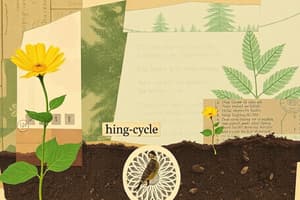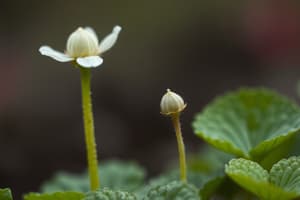Podcast
Questions and Answers
What is the primary function of the seed coat?
What is the primary function of the seed coat?
- To protect the seed from physical damage (correct)
- To produce leaves
- To absorb water
- To provide food to the embryo
Cotyledons are modified roots.
Cotyledons are modified roots.
False (B)
What is the baby plant inside the seed called?
What is the baby plant inside the seed called?
Embryo
The tiny opening on the seed coat that absorbs water is called the ___________________.
The tiny opening on the seed coat that absorbs water is called the ___________________.
Match the following seed parts with their functions:
Match the following seed parts with their functions:
The ___________________ develops into the roots of the plant.
The ___________________ develops into the roots of the plant.
What is the function of cotyledons?
What is the function of cotyledons?
All seeds are round in shape.
All seeds are round in shape.
What is the role of radicle in the embryo of a seed?
What is the role of radicle in the embryo of a seed?
All seeds have two seed leaves.
All seeds have two seed leaves.
What is the term for the seed leaves of a plant?
What is the term for the seed leaves of a plant?
Seeds can be classified into two main types based on the number of _______________ they have.
Seeds can be classified into two main types based on the number of _______________ they have.
Match the following seeds with their types:
Match the following seeds with their types:
What is the function of the plumule in the embryo of a seed?
What is the function of the plumule in the embryo of a seed?
What is the characteristic of orchid seeds?
What is the characteristic of orchid seeds?
What is the main difference between monocot and dicot seeds?
What is the main difference between monocot and dicot seeds?
Monocot seeds have two cotyledons.
Monocot seeds have two cotyledons.
The plumule is located in the ______________ of the embryo.
The plumule is located in the ______________ of the embryo.
Which part of the embryo grows into the root of the plant?
Which part of the embryo grows into the root of the plant?
Match the following seed types with their characteristics:
Match the following seed types with their characteristics:
The hilum is the scar where the seed was ______________ to the parent plant.
The hilum is the scar where the seed was ______________ to the parent plant.
The seed coat is the outermost layer of the seed.
The seed coat is the outermost layer of the seed.
Flashcards are hidden until you start studying
Study Notes
Seed Structure
- A seed has three main parts: seed coat, cotyledons, and embryo
- Seed coat: protects the seed from physical and temperature-related damage
- Hilum: a tiny opening in the seed coat that absorbs water
- Cotyledons: fleshy parts or seed leaves that provide food for the growing embryo
- Embryo: the baby plant inside the seed, consists of radicle (roots) and plumule (shoot of the plant)
Types of Seeds
- There are two types of seeds: monocotyledonous and dicotyledonous
- Monocotyledonous seeds have one seed leaf (e.g., wheat, bajra, maize, and rice)
- Dicotyledonous seeds have two seed leaves (e.g., mango, gram, and pea)
Radicle and Plumule
- Radicle develops into the roots of the baby plant
- Plumule develops into the shoot of the baby plant
Fun Facts
- Orchids have the smallest seeds, each seed is the size of a speck of dust!
Studying That Suits You
Use AI to generate personalized quizzes and flashcards to suit your learning preferences.




